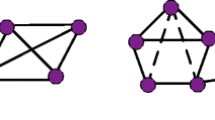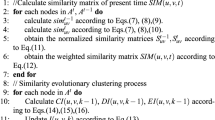Abstract
To detect communities in signed networks consisting of both positive and negative links, two new evolutionary algorithms (EAs) and two new memetic algorithms (MAs) are proposed and compared. Furthermore, two measures, namely the improved modularity Q and the improved modularity density D-value, are used as the objective functions. The improved measures not only preserve all properties of the original ones, but also have the ability of dealing with negative links. Moreover, D-value can also control the partition to different resolutions. To fully investigate the performance of these four algorithms and the two objective functions, benchmark social networks and various large-scale randomly generated signed networks are used in the experiments. The experimental results not only show the capability and high efficiency of the four algorithms in successfully detecting communities from signed networks, but also indicate that the two MAs outperform the two EAs in terms of the solution quality and the computational cost. Moreover, by tuning the parameter in D-value, the four algorithms have the multi-resolution ability.



















Similar content being viewed by others
References
Acampora G, Gaeta M, Loia V (2011a) Combining multi-agent paradigm and memetic computing for personalized and adaptive learning experiences. Comput Intell 27(2):141–165
Acampora G, Cadenas JM, Loia V, Ballester EM (2011b) Achieving memetic adaptability by means of agent-based machine learning. IEEE Trans Ind Inform 7(4):557–569
Acampora G, Cadenas JM, Loia V, Ballester EM (2011c) A multi-agent memetic system for human-based knowledge selection. IEEE Trans Syst Man Cybern Part A 41(5):946–960
Acampora G, Loia V, Salerno S, Vitiello A (2012) A hybrid evolutionary approach for solving the ontology alignment problem. Int J Intell Syst 27(3):189–216
Albert R, Barabási AL (2002) Statistical mechanics of complex networks. Phys Rev Mod 74(1):47–97
Angelini L, Boccaletti S, Marinazzo D, Pellicoro M, Stramaglia S (2007) Identification of network modules by optimization of ratio association. Chaos 17(2):023114
Badillo AR, Ruiz JJ, Cotta C, Fernández-Leiva AJ (2013) On user-centric memetic algorithms. Soft Comput 17(2):285–300
Barnes ER (1982) An algorithm for partitioning the nodes of a graph. SIAM J Algebr Discret Methods 3(4):541–550
Bezdek JC (1981) Pattern recognition with fuzzy objective function algorithms. Kluwer Academic Publishers, Norwell
Cabido R, Montemayor AS, Pantrigo JJ (2012) High performance memetic algorithm particle filter for multiple object tracking on modern GPUs. Soft Comput 16(2):217–230
Clauset A, Newman MEJ, Moore C (2004) Finding community structure in very large networks. Phys Rev E 70(6):066111
Danon L, Díaz-Guilera A, Duch J, Arenas A (2005) Comparing community structure identification. J Stat Mech 9:008
Dawkins R (1989) The Selfish Gene. Oxford University, NewYork
Deng W, Chen R, He B, Liu YQ, Yin LF, Guo JH (2012) A novel two-stage hybrid swarm intelligence optimization algorithm and application. Soft Comput 16(10):1707–1722
Doreian P (2008) A multiple indicator approach to blockmodeling signed networks. Soc Netw 30:247–258
Doreian P, Mrvar A (1996) A partitioning approach to structural balance. Soc Netw 18(2):149–168
Doreian P, Batagelj V, Ferligoj A (2005) Generalized blockmodeling. Cambridge University Press, New York
Dorogovtsev SN, Mendes JFF (2002) Evolution of networks. Adv Phys 51(4):11079–11187
Duch J, Arenas A (2005) Community detection in complex networks using extremal optimization. Phys Rev E 70(2):027104
Dunn JC (1973) A fuzzy relative of the isodata process and its use in detecting compact well-separated clusters. J Cybern 3(3):32–57
Fortunato S, Barthelemy M (2007) Resolution limit in community detection. Proc Natl Acad Sci 104(1):36–41
Girvan M, Newman MEJ (2002) Community structure in social and biological networks. Proc Natl Acad Sci USA 99(12):7821–7826
GÓmez S, Jensen P, Arenas A (2009) Analysis of community structure in networks of correlated data. Phys Rev E 80(1):016114
Gong MG, Fu B, Jiao LC, Du HF (2011) Memetic algorithm for community detection in networks. Phys Rev E 84(5):056101
Guimerà R, Sales-Pardo M, Amaral LAN (2004) Modularity from fluctuations in random graphs and complex networks. Phys Rev E 70(2):025101
Hastie T, Tibshirani R, Friedman JH (2001) The elements of statistical learning. Springer, Berlin
He DX, Zhou X, Wang Z, Zhou CG, Wang Z, Jin D (2010) Community mining in complex networks clustering combination based genetic algorithm. Acta Automatica Sinica 36(8):1160–1170
Hughes BD (1996) Random walks and random environments: random walks. Clarendon Press, Oxford
Jiao L, Liu J, Zhong W (2006) An organizational coevolutionary algorithm for classification. IEEE Trans Evolut Comput 10(1):67–80
Jin D, He DX, Liu DY, Baquero C (2010) Genetic algorithm with local search for community mining in complex networks. In: Proceedings of the 22nd IEEE international conference on tools with artificial intelligence. IEEE, Arras, France, pp 105–112
Kernighan BW, Lin S (1970) An efficient heuristic procedure for partitioning graphs. Bell Syst Technical J 49(2):291–307
Krasnogor N, Smith J (2005) A tutorial for competent memetic algorithms: model, taxonomy, and design issues. IEEE Trans Evolut Comput 9(5):474–488
Kropivnik S, Mrvar A (1996) An analysis of the slovenian parliamentary political parties network. In: Ferligoj A, Kramberger A (eds), Developments in data analysis. Metodološki zvezki, 12, Ljubljana: FDV, pp 209–216
Li ZP, Zhang SH, Wang RS, Zhang XS, Chen L (2008) Quantitative function for community detection. Phys Rev E 77(3):036109
Li SZ, Chen YH, Du HF, Feldman MW (2010) A genetic algorithm with local search strategy for improved detection of community structure. Complexity 15(4):53–60
Liu J, Zhong W, Jiao L (2006) A multiagent evolutionary algorithm for constraint satisfaction problems. IEEE Trans Syst Man Cybern Part B 36(1):54–73
Liu J, Zhong W, Jiao L (2008) Moving block sequence and organizational evolutionary algorithm for general floorplanning with arbitrarily shaped rectilinear blocks. IEEE Trans Evolut Comput 12(5):630–646
Liu J, Zhong W, Jiao L (2010) A multiagent evolutionary algorithm for combinatorial optimization problems. IEEE Trans Syst Man Cybern Part B 40(1):229–240
MacQueen JB (1967) Some methods for classification and analysis of multivariate observations. In: Cam LML, Neyman J (eds) Proceedings of the fifth Berkeley symposium on mathematical statistics and probability, pp 281–297
Marić M, Stanimirović Z, Stanojević P (2013) An efficient memetic algorithm for the uncapacitated single allocation hub location problem. Soft Comput 17(3):445–466
Moscato P (1989) On evolution, search, optimization, genetic algorithms and martial arts-towards memetic algorithms. Caltech concurrent computation program (C3P), Report
Moscato P, Cotta C (2003) A gentle introduction to memetic algorithms. International series in operations research & management science, vol 57, pp 105–144. Springer, New York
Newman MEJ (2004a) Fast algorithm for detecting community structure in networks. Phys Rev E 69(6):066133
Newman MEJ (2004b) Analysis of weighted networks. Phys Rev E 70(5):056131
Newman MEJ, Girvan M (2004) Finding and evaluating community structure in networks. Phys Rev E 69(2):026133
Ni JC, Li L, Qiao F, Wu QD (2013) A novel memetic algorithm and its application to data clustering. Memet Comput 5(1):65–78
Peng Y, Lu BL (2012) A hierarchical particle swarm optimizer with latin sampling based memetic algorithm for numerical optimization. Soft Comput 13(5):2823–2836
Pizzuti C (2008) GA-Net: A genetic algorithm for community detection in social networks. In: Lecture notes in computer science, PPSN X, vol 5199, pp 1081–1090
Pizzuti C (2008) Community detection in social networks with genetic algorithms. In: Proceedings of the 10th annual conference on genetic and evolutionary computation. ACM, New York, pp 1137–1138
Pizzuti C (2009) A multi-objective genetic algorithm for community detection in networks. In: Proceedings of the 21st IEEE international conference on tools with artificial intelligence. IEEE, New Jersey, pp 379–386
Pujol JM, Béjar J, Delgado J (2006) Clustering algorithm for determining community structure in large networks. Phys Rev E 74(1):016107
Read KE (1954) Cultures of the central highlands, new guinea. Southwest J Anthropol 10(1):1–43
Shi J, Malik J (1997) Normalized cuts and image segmentation. In: CVPR ‘97: Proceedings of the 1997 conference on computer vision and pattern recognition, CVPR ‘97, IEEE Computer Society, Washington
Shi J, Malik J (2000) Normalized cuts and image segmentation. IEEE Trans Pattern Anal Mach Intell 22(8):888–905
Shi C, Yan ZY, Yi W, Cai YN, Wu B (2010) A genetic algorithm for detecting communities in large-scale complex networks. Adv Complex Syst 13(1):3–17
Tasgin M, Herdagdelen A, Bingol H (2007) Community detection in complex networks using genetic algorithms. Phys Soc-Ph
Traag VA, Bruggeman J (2009) Community detection in networks with positive and negative links. Phys Rev E 80(3):036115
Wu FY (1982) The potts model. Phys Rev Mod 54(1):235–268
Wu F, Huberman BA (2004) Finding communities in linear time: a physics approach. Eur Phys J B 38:331–338
Wu L, Ying XW, Wu XT, Lu AD, Zhou ZH (2011) Spectral analysis of k-balance signed graphs. In: the 15th Pacific-Asia conference on knowledge discovery and data mining, pp 1–12
Yang B, Cheung WK, Liu JM (2007) Community mining from signed social networks. IEEE Trans Knowl Data Eng 19(10):1333–1348
Zhang L (2008) Research and application in immune clone intelligent optimization algorithm, Master Thesis, Northwest University, China
Zhong W, Liu J, Xue X, Jiao L (2004) A multiagent genetic algorithm for global numerical optimization. IEEE Trans Syst Man Cybern Part B 34(2):1128–1141
Zhou H, Lipowsky R (2004) Network brownian motion: a new method to measure vertex–vertex proximity and to identify communities and subcommunities. Lect Notes Comput Sci 3038:1062–1069
Acknowledgments
This work is partially supported by the National Natural Science Foundation of China under Grants 61271301 and 61103119, and the Fundamental Research Funds for the Central Universities under Grant K5051202052.
Author information
Authors and Affiliations
Corresponding author
Additional information
Communicated by G. Acampora.
Rights and permissions
About this article
Cite this article
Li, Y., Liu, J. & Liu, C. A comparative analysis of evolutionary and memetic algorithms for community detection from signed social networks. Soft Comput 18, 329–348 (2014). https://doi.org/10.1007/s00500-013-1060-4
Published:
Issue Date:
DOI: https://doi.org/10.1007/s00500-013-1060-4




